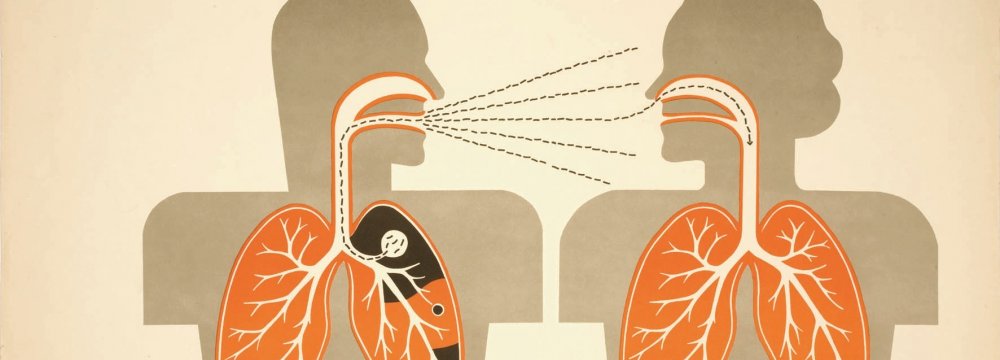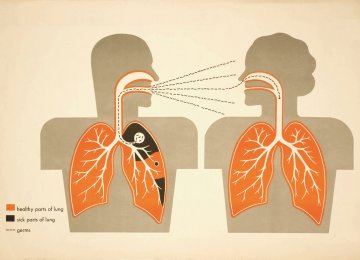The Health Ministry says tuberculosis (TB) has far from disappeared and lack of adequate screening programs means there are still plenty of undiagnosed and untreated cases in the country.
“Based on official figures, one in three Iranians has TB bacteria that are alive, but inactive,” said Dr Mohammad Mahdi Guya, head of the ministry’s Center for Infectious Diseases. He was speaking on the sidelines of a ceremony to mark the National TB Day last week in Tehran.
People infected with TB bacteria have a 10% lifetime risk of falling ill with the disease. However, those with compromised immune systems, such as people living with HIV, malnutrition or uncontrolled diabetes, or people who use tobacco, are at a much higher risk, the Persian language weekly ‘Salamat’ reported.
Currently, the TB incidence rate is 16 per 100,000 people in the country (although World Bank data shows the rate is 22 per 100,000).
In 1964, the reported incidence rate of TB in Iran had soared to 143 cases per 100,000 people. Since then, a gradual and steady improvement of the general socio-economic and health indices led to a drastic reduction in TB incidence rates such that by 2014 this ratio had dropped to 12.9 per 100,000.
During 2008-2014, in collaboration with the World Health Organization, Iran achieved its TB control goals as stipulated in the National Strategic Plan on TB.
“However, 22% of all cases are not reported as some people tend to ignore the symptoms. So far, about 13,000 people have been diagnosed with the disease while the actual number of TB patients is estimated at 16,000,” said Dr Mahshid Nasehi, head of the ministry’s TB and Leprosy Control Center.
The disease prevalence is particularly high in the provinces of Gilan, Sistan-Baluchistan, Golestan, Khorasan Razavi, Qom, and Khuzestan, she added.
TB is most prevalent in Sistan-Baluchistan and Golestan provinces due to malnutrition and proximity to high-risk states such as Afghanistan and Pakistan.
The World Health Assembly, convened annually by the WHO at the UN’s European headquarters in Geneva, passed a resolution in May 2014 approving the new post-2015 Global TB Strategy that ambitiously targets an 80% drop in new TB cases, and a 90% decline in people dying of TB by 2030.
“Our plans are under review and revision based on the new agenda,” Nasehi had said earlier.
The disease incidence rate is higher in Iran than in countries in the pre-elimination phase. According to the WHO, at present there are 33 countries and territories where there are fewer than 100 TB cases per million people.
Measures for Disease Control
Guya further pointed to measures taken so far with the aim to reduce the disease burden. “Three years ago, there was only one center for treatment of drug-resistant TB, but today the number has increased to six. The centers provide free treatment services to TB patients in Tehran, Shiraz, Tabriz, Isfahan, Mashhad, and Sistan-Baluchistan Province.”
More centers will be launched by the end of the year in March 2017. Also, there are 13 TB diagnosis laboratories across the country.
“Last fiscal year that ended in March, around 9,915 new cases of TB were registered, among whom 48 were suffering from drug-resistant TB (20-40% were foreign nationals),” he said.
Drug-resistant tuberculosis is defined as a form of TB infection caused by bacteria that are resistant to treatment with at least two of the most powerful first-line anti-TB drugs, isoniazid (INH) and rifampicin (RMP).
Drug resistant TB is more difficult to treat than drug susceptible TB. It requires the use of ‘second line’ drugs that are more costly and cause greater side effects. Cure rates for TB are above 90% if medicine is taken properly and the prescription is completed. For patients with multi-drug resistant TB, cure rates are only 50%.
Treatment Costly
According to Guya, the government spends $130 for each treatment cycle provided to TB patients. The figure increases to $11,400 for patients suffering from drug-resistant TB. On average, the complete TB treatment costs between $5700 and $14,300 (200 million rials to 500 million rials) per patient, he added.
In Iran, TB is the leading cause of death among people living with HIV, and 30% of all HIV-infected people die from the disease. Addicts and people living with hepatitis B/C have a much greater risk of falling ill with the disease.
Official figures say 20% of people suffering from TB are addicted to illegal drugs. Since the year 2003, TB detection and control programs are being implemented in all prisons across the country where the incidence is much higher.
Tuberculosis (TB) is a bacterial infection spread through inhaling tiny droplets from the cough or sneeze of an infected person. It is a serious condition, but can be cured with proper treatment. TB mainly affects the lungs.
It is one of the top 10 causes of death worldwide. In 2015, 10.4 million people fell ill with TB and 1.8 million died from the disease (including 0.4 million among people with HIV). Over 95% of TB deaths occur in low and middle-income countries.
Six countries account for 60% of the total, with India leading the count, followed by Indonesia, China, Nigeria, Pakistan (which has a common border with Iran) and South Africa.






Add new comment
Read our comment policy before posting your viewpoints